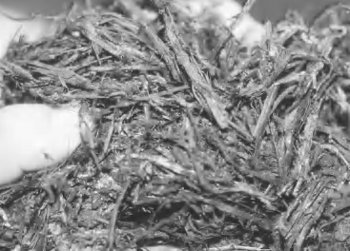Substrate Supplementation
The compost has to provide the mushroom mycelium with a smorgasbord of food. Not only is ligninhumus complex and cellulose important, but protein, fat, and oils are also important. A good analogy is protein serves as the mushroom’s «steak», carbohydrates its »potatoes», and lipids (fats and oils) its »butter». Like people, mushrooms should eat a balance of all these food types. The main source of »steak and butter» for the mushroom is from Phase II microbes. The dead cells of thermophilic fungi, bacteria, and actinomycetes «firefang» are the packages that deliver protein and fat to the mushroom (Figure 9). The addition of delayed-release supplements further enhances the protein and lipid content of the compost for the mushroom. Many of these supplements consist of a high-protein oil material, such as soybean meal, cornmeal, or feather meal, that has been treated to delay the availability of the nutrient for the mushroom. If an untreated supplement is added to the compost at this time, it often becomes a »candy bar» to other microbes, weeds, or competitor molds. These molds grow more rapidly than the mushroom mycelium and can quickly colonize the compost, competing with the mushroom for nutrients. The oils or lipids in these supplements are used by the mushroom to stimulate the fruiting mechanism and increase yield by having more mushrooms initiate and develop. Yields can be increased from 0.25 to 1.5 lbs/sq ft of growing space. In addition, mushroom size may also be improved in compost with higher spawning-moisture content. However, in substrate that is not selectively prepared, these nutrients become more available to com-petitor molds. Often, if a farm is having composting problems, not supplementing until the problems are corrected is more economical.

Figure 9. Handful of composted substrate showing the white-flecking ( «firefang») microbial growth.
3795 view.